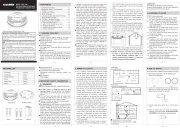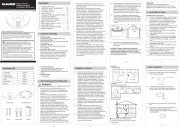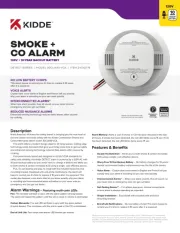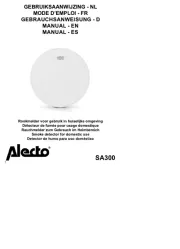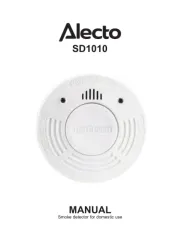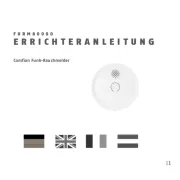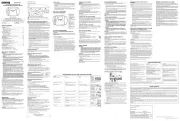
IMPORTANT! PLEASE READ CAREFULLY AND SAVE.
This user's manual contains important information about your
Smoke Alarm's operation. If you are installing this Smoke Alarm for
use by others, you must leave this manual—or a copy of it—with
2. IMPORTANT SAFETY INFORMATION 02……… …
3. WHERE TO LOCATE 04………………………………
4. LOCATIONS TO AVOID 07……………………………
5. HOW TO INSTALL 08…………………………………
6. LED INDICATORS AND HORN PATTERNS 10……
7. FALSE ALARM CONTROL 11………………………
8. TESTING THE SMOKE ALARM 11…………………
9. MAINTENANCE AND CLEANING 12………………
10. PRACTICE FIRE SAFETY 13………………………
11. WHAT TO DO IN CASE OF A FIRE 14……………
12. TROUBLESHOOTING 15……………………………
13. LIMITATIONS OF SMOKE ALARMS 15……………
14. LIMITED WARRANTY 18……………………………
3.1 As a minimum, smoke alarms should be located
between sleeping areas and potential sources of fire
such as living rooms and kitchens. In single story
homes with one sleeping area, a smoke alarm should
be installed in the hallway, as close as possible to the
living accommodation. To ensure audibility in bedrooms,
no smoke alarm should be further away than 3m from
any bedroom door. It may be necessary to install more
than one smoke alarm, particularly the hallway is more
than 15m long. In single story homes with two separate
sleeping areas, a minimum of two smoke alarms is
required, one outside each sleeping area. In multilevel
or split level homes, as a minimum a smoke alarm
should be installed on the ground floor between the
staircase and any rooms in which a fire might start and
in circulation areas which form part of
escape route (normally hallways and landings).
3.2 Additional alarms should be installed in bedrooms in
anticipation of fires originating here, caused by faulty
wiring, lights, appliances, smokers or other hazards.
3.3 For best protection, smoke alarms should be installed
in every room in your home, apart from those listed in
the Section 4 LOCATIONS TO AVOID. Heat alarms
should be used in kitchens, boiler rooms, laundry
rooms, garages and such like, where smoke alarms
3.4 Install smoke alarms in circulation areas at a distance
no greater than 7.5m from the farthest wall, no greater
5.1 Remove the smoke alarm from the packaging and
detach the mounting plate
5.3 Drill the holes at the marks with a 3/16-inch (5mm)
2. IMPORTANT SAFETY INFORMATION
PLEASE READ AND SAVE THESE INSTRUCTIONS.
●DO NOT remove or disconnect battery to quiet
unwanted alarms. This will remove your protection.
Open windows or fan the air around smoke alarm to
●The test button accurately tests all smoke alarm
functions. DO NOT use any other test method. Test
smoke alarm weekly to ensure proper operation.
Observe and follow all local and national electrical
and building codes for installation.
●This smoke alarm IS NOT designed to be the PRIMARY
protection for buildings that require complete fire alarm
systems. Buildings of this type include hotels, motels,
dormitories, hospitals, nursing homes, and group
homes. This is true even if they were once single family
homes. However, this smoke alarm MAY be used inside
individual rooms as SUPPLEMENTAL protection.
●Install a smoke alarm in every room and on every level
of the home. Smoke may not reach the smoke alarm for
many reasons. For example, if a fire starts in a remote
part of the home, on another level, in a chimney, wall,
roof, or on the other side of a closed door, smoke may
Photoelectric alarms are generally more effective at detecting
slow, smoldering fires that smolder for hours before bursting
into flame. Sources of these fires may include cigarettes burning in
Ionization alarms are generally more effective at detecting
fast, flaming fires that consume combustible materials rapidly
and spread quickly. Sources of these fires may include flammable
liquids or paper burning in a waste container.
However, both types of alarms provide adequate detection of both
If you desire the earliest detection of both smoldering fires and fast
flaming fires, you should install smoke alarms that combine both
photoelectric and ionization sensing technologies in one unit.
Long-life lithium-ion battery sealed in the alarm to
lengthen its lifetime to 10 years in standby condition.
Flashes approximately every
Alarm beeps every 40 seconds when the battery needs
Silence your smoke alarm by momentarily pressing the
test button when non-emergency smoke (e.g. steam),
causes nuisance alarms. The red light flashes every 10
seconds to remind you that the smoke alarm has been
silenced. The alarm will automatically reset after 9
Test the sensitivity, circuitry, batteries, horn.
●Loud 85 Decibel Piezo Electric Alarm
Automatically resets when hazardous condition has
not reach the smoke alarm in time to alert household
members. A smoke alarm will not promptly detect a fire
EXCEPT in the area or room in which it is installed.
●Smoke alarms may not alert every household member
every time. The alarm horn is loud in order to alert
individuals to a potential danger. However, there may be
limiting circumstances where a household member may
not hear the alarm (i.e., outdoor or indoor noise, sound
sleepers, drug or alcohol usage, the hard of hearing,
etc.). If you suspect that this smoke alarm may not alert
a household member, install and maintain specialty
smoke alarms. Household members must hear the
alarm's warning sound and quickly respond to it to
reduce the risk of damage, injury, or death that may
result from fire. If a household member is hard of
hearing, install special smoke alarms with lights or
vibrating devices to alert occupants.
●Smoke alarms can sound their alarms only when they
detect smoke. Smoke alarms detect combustion
particles in the air. They do not sense heat, flame, or
gas. This smoke alarm is designed to give audible
warning of a developing fire. However, many fires are
fast-burning, explosive, or intentional. Oth
caused by carelessness or safety hazards. Smoke may
not reach the smoke alarm QUICKLY ENOUGH to
●Smoke alarms have limitations. This smoke alarm is not
foolproof and is not warranted to protect lives or
property from fire. Smoke alarms are not a substitute for
insurance. Homeowners and renters should insure their
lives and property. In addition, it is possible for the
smoke alarm to fail at any time. For this reason, you
must test the smoke alarm weekly and replace every 10
than 7.5m from a door to any room in which a fire might
start and no greater than 7.5m from the next smoke
3.5 As it is impossible to predict the source of a fire, the
best location for an alarm is usually the center of a
room or hallway. If it is necessary to place a smoke
alarm on a wall, always locate the detection element of
the alarm 150mm to 300mm (6 to 12 inches) below the
ceiling and the bottom of the alarm above the level of
doors and other openings.
3.6 In rooms with simple sloped, peaked or gabled ceilings,
install smoke alarms on the ceiling 900mm (3 feet) from
the highest point of the ceiling. “Dead air” at the peak of
a ceiling may prevent the smoke from reaching the
alarm in time to provide an early warning.
3.7 Read Section 4 LOCATIONS TO AVOID and Section
13 LIMITATIONS OF SMOKE ALARMS in this manual.
CAUTION: Research indicates that substantial
increases in warning time can be obtained with
each properly installed, additional alarm. It is
strongly recommended that advice in 3.3 above be
followed to ensure maximum protection.
more than one sleeping areas
Smoke alarms for limited protection
Additional smoke alarms for better coverage
These alarms are intended to primarily for single-
occupancy private dwellings. For use in other applications
the manufacturer's advice must be sought.
DO NOT locate smoke alarms :
4.1 In turbulent air from fans, heaters, doors, windows,
etc., which could draw smoke away from the alarm.
4.2 In high humidity area such as bathrooms and shower
rooms, or where the temperature exceeds 39˚C (
100˚F) or falls below 5˚C ( 40˚F), as high humidity can
4.3 A t the peak of an “A” frame ceiling. “Dead air” at the
top may prevent smoke from reaching the alarm in
time to provide early warning.
4.4 Less than 300mm (12 inches) from the wall when
4.5 In insect-infested areas. Tiny insects may affect
4.6 In kitchens, boiler rooms, laundry rooms, garages.
Combustion particles from cooking or car exhaust and
ould trigger a nuisance alarm.
4.7 In very dusty or dirty areas. Dirt and dust can build up
4.8 Within 300mm (12 inches) of light fittings or room
4.9 In locations which would make routine testing or
maintenance hazardous (e.g. over a stairwell).
4.10 On poorly insulated walls or ceilings.
4.11 Near objects such as ceiling decorations which might
impede the path of smoke to the alarm.
4.12 Within 1500mm (5 feet) of fluorescent light fittings.
Ten-year Battery Operated
Photoelectric Smoke Alarm
Standards tested to: EN14604:2005/AC:2008
Warning! Test unit before installation and when installation is completed.
Locate the mounting bracket in your chosen position.
Align the two longest mounting slots with the line.
Draw a mark in the center of each slot.
5.4 Insert the anchor plugs and screw the mounting
bracket to the chosen position.
, this will distort the mounting bracket.
